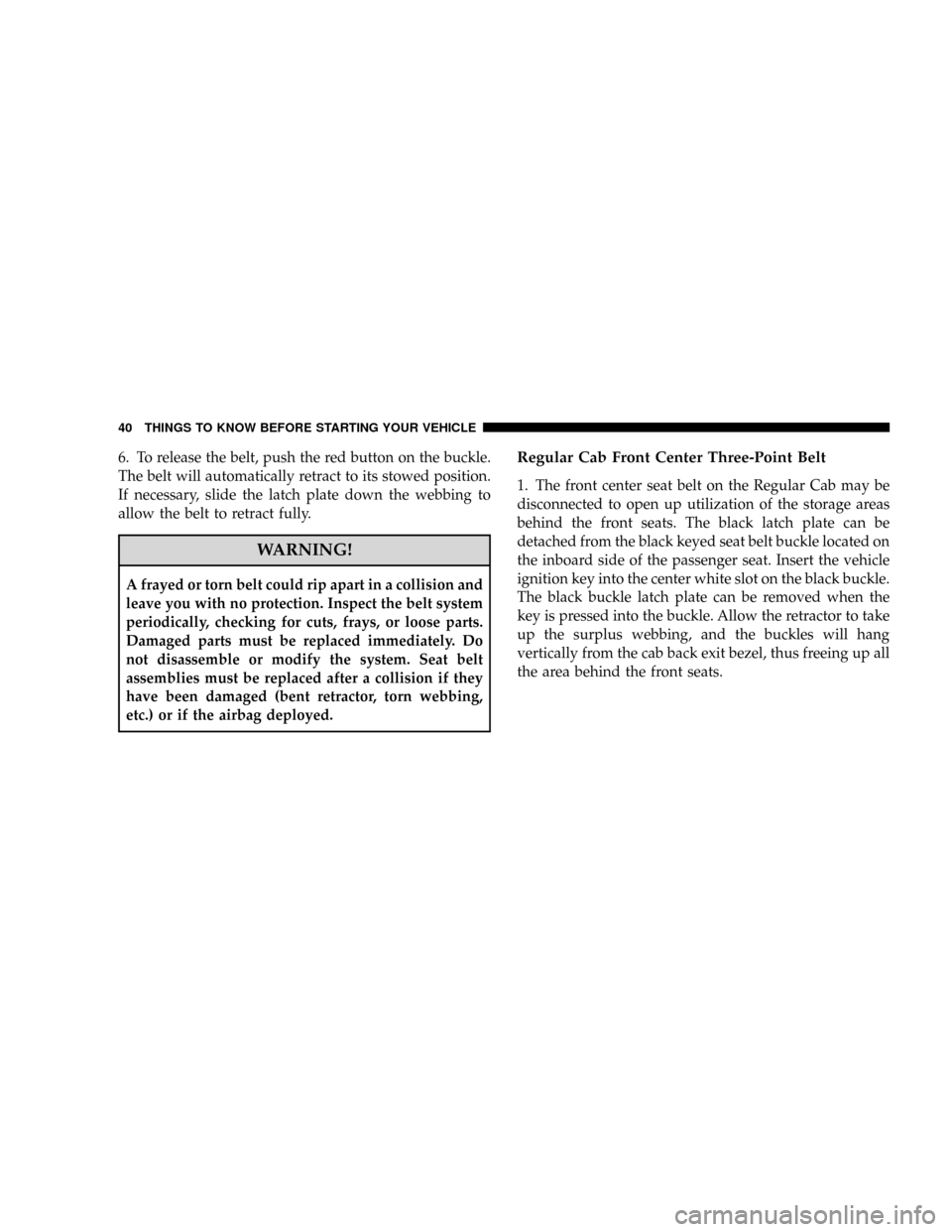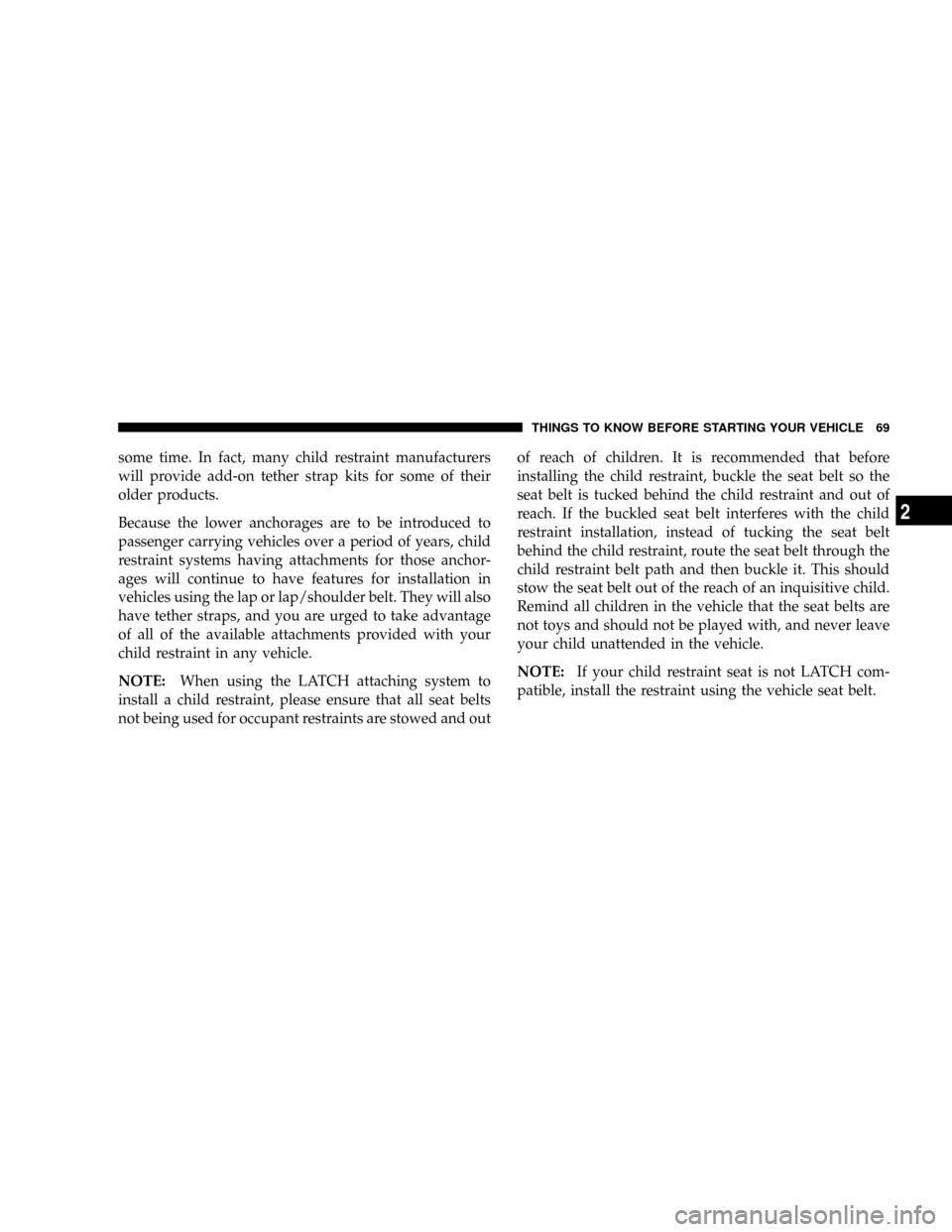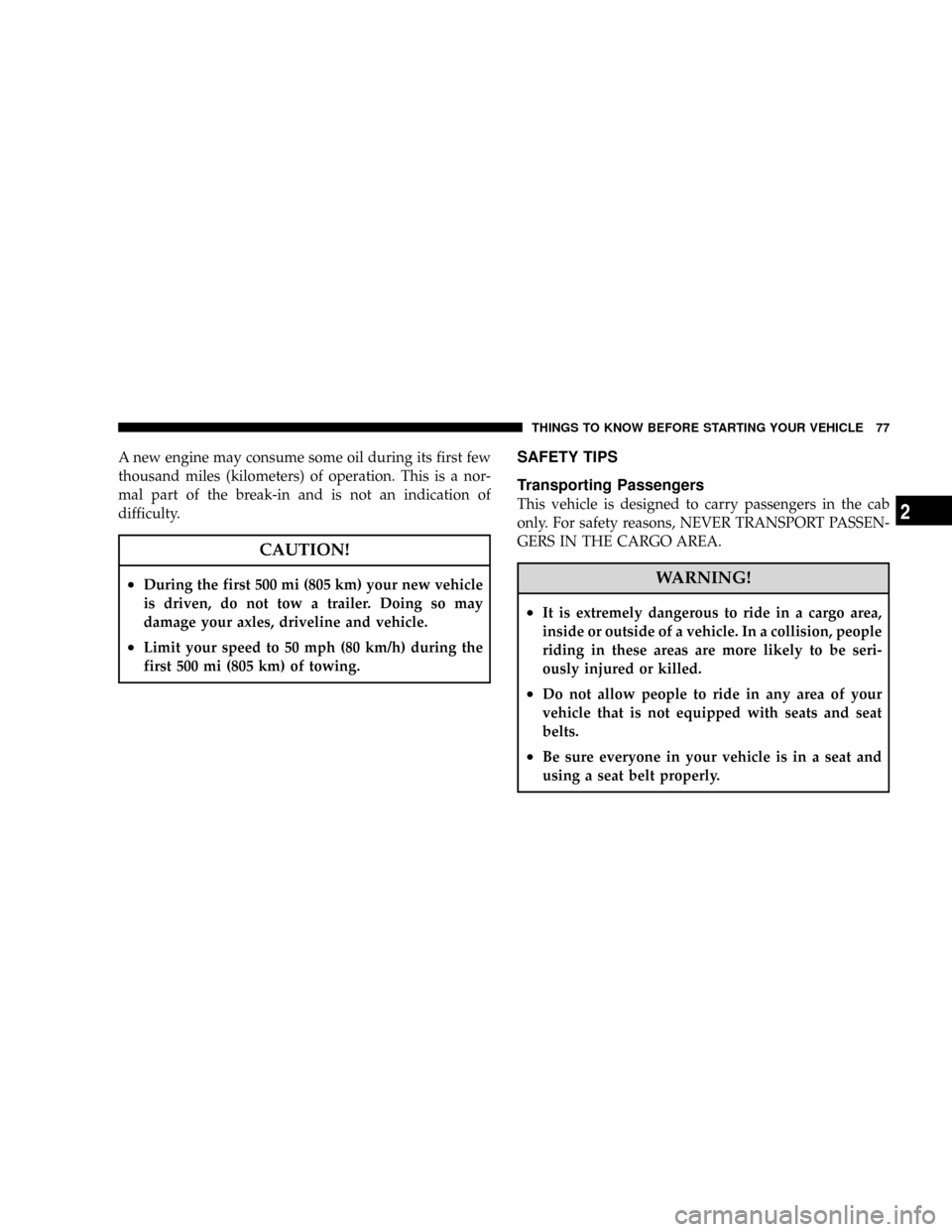Page 26 of 554
If your Remote Keyless Entry Transmitter (RKE) fails to
operate from a normal distance, check for these two
conditions:
1. Weak batteries in transmitter. The expected life of the
batteries is from one to two years.
2. Closeness to a radio transmitter such as a radio station
tower, airport transmitter, and some mobile or CB radios.Transmitter Battery Service
NOTE:Perchlorate Material ± special handling may apply,
see www.dtsc.ca.gov/hazardouswaste/perchlorate
The recommended replacement battery is CR2032.
RKE Transmitter Battery Replacement
24 THINGS TO KNOW BEFORE STARTING YOUR VEHICLE
Page 42 of 554

6. To release the belt, push the red button on the buckle.
The belt will automatically retract to its stowed position.
If necessary, slide the latch plate down the webbing to
allow the belt to retract fully.
WARNING!
A frayed or torn belt could rip apart in a collision and
leave you with no protection. Inspect the belt system
periodically, checking for cuts, frays, or loose parts.
Damaged parts must be replaced immediately. Do
not disassemble or modify the system. Seat belt
assemblies must be replaced after a collision if they
have been damaged (bent retractor, torn webbing,
etc.) or if the airbag deployed.
Regular Cab Front Center Three-Point Belt
1. The front center seat belt on the Regular Cab may be
disconnected to open up utilization of the storage areas
behind the front seats. The black latch plate can be
detached from the black keyed seat belt buckle located on
the inboard side of the passenger seat. Insert the vehicle
ignition key into the center white slot on the black buckle.
The black buckle latch plate can be removed when the
key is pressed into the buckle. Allow the retractor to take
up the surplus webbing, and the buckles will hang
vertically from the cab back exit bezel, thus freeing up all
the area behind the front seats.
40 THINGS TO KNOW BEFORE STARTING YOUR VEHICLE
Page 71 of 554

some time. In fact, many child restraint manufacturers
will provide add-on tether strap kits for some of their
older products.
Because the lower anchorages are to be introduced to
passenger carrying vehicles over a period of years, child
restraint systems having attachments for those anchor-
ages will continue to have features for installation in
vehicles using the lap or lap/shoulder belt. They will also
have tether straps, and you are urged to take advantage
of all of the available attachments provided with your
child restraint in any vehicle.
NOTE:When using the LATCH attaching system to
install a child restraint, please ensure that all seat belts
not being used for occupant restraints are stowed and outof reach of children. It is recommended that before
installing the child restraint, buckle the seat belt so the
seat belt is tucked behind the child restraint and out of
reach. If the buckled seat belt interferes with the child
restraint installation, instead of tucking the seat belt
behind the child restraint, route the seat belt through the
child restraint belt path and then buckle it. This should
stow the seat belt out of the reach of an inquisitive child.
Remind all children in the vehicle that the seat belts are
not toys and should not be played with, and never leave
your child unattended in the vehicle.
NOTE:If your child restraint seat is not LATCH com-
patible, install the restraint using the vehicle seat belt.
THINGS TO KNOW BEFORE STARTING YOUR VEHICLE 69
2
Page 79 of 554

A new engine may consume some oil during its first few
thousand miles (kilometers) of operation. This is a nor-
mal part of the break-in and is not an indication of
difficulty.
CAUTION!
²During the first 500 mi (805 km) your new vehicle
is driven, do not tow a trailer. Doing so may
damage your axles, driveline and vehicle.
²Limit your speed to 50 mph (80 km/h) during the
first 500 mi (805 km) of towing.
SAFETY TIPS
Transporting Passengers
This vehicle is designed to carry passengers in the cab
only. For safety reasons, NEVER TRANSPORT PASSEN-
GERS IN THE CARGO AREA.
WARNING!
²It is extremely dangerous to ride in a cargo area,
inside or outside of a vehicle. In a collision, people
riding in these areas are more likely to be seri-
ously injured or killed.
²Do not allow people to ride in any area of your
vehicle that is not equipped with seats and seat
belts.
²Be sure everyone in your vehicle is in a seat and
using a seat belt properly.
THINGS TO KNOW BEFORE STARTING YOUR VEHICLE 77
2
Page 83 of 554
UNDERSTANDING THE FEATURES OF YOUR VEHICLE
CONTENTS
mMirrors...............................86
NInside Mirror.........................86
NAutomatic Dimming Mirror ± If Equipped....87
NOutside Mirrors.......................87
NExterior Mirrors Folding Feature...........88
NElectronic Power Mirrors ± If Equipped......88
NElectric Rear Window Defroster And Heated
Sideview Mirrors ± If Equipped............89
NTrailer Towing Mirrors ± If Equipped........89mHands-Free Communication (UConnectt)Ð
If Equipped............................91
NOperation............................93
NPhone Call Features...................100
NUConnecttSystem Features..............102
NAdvanced Phone Connectivity............107
NThings You Should Know About Your
UConnecttSystem....................109
NGeneral Information...................117
3
Page 88 of 554
MIRRORS
Inside Mirror
The mirror should be adjusted to center on the view
through the rear window.
Annoying headlight glare can be reduced by moving the
small control under the mirror to the night position
(toward rear of vehicle). The mirror should be adjusted
while set in the day position (toward windshield).
Adjusting Rearview Mirror
86 UNDERSTANDING THE FEATURES OF YOUR VEHICLE
Page 91 of 554

Set the top switch to the left or right for the left or right
mirror, and set it to the center off position to prevent
accidentally moving a mirror when you are finished
adjusting the mirror. To adjust a mirror, select left or right
with the top switch, and press one of the four arrows for
the direction you want the mirror to move.
Electric Rear Window Defroster and Heated
Sideview Mirrors ± If Equipped
The Electric Rear Window Defroster and Heated
Sideview Mirrors are activated by pressing the
heated grid button, located on the Climate Control panel,
with the ignition ON. Turning Off the rear window
defroster or the ignition will deactivate the Electric Rear
Window Defroster and Heated Sideview Mirrors feature.
These features turn off automatically after 15 minutes
have elapsed for the first activation per ignition cycle.
Each subsequent activation of these features per ignition
cycle will shut off automatically after 10 minutes have
elapsed. To reactivate, simply press the button again.
Trailer Towing Mirrors ± If Equipped
These mirrors are designed with an adjustable mirror
head to provide a greater vision range when towing
Power Mirror Switches
UNDERSTANDING THE FEATURES OF YOUR VEHICLE 89
3
Page 92 of 554
extra-wide loads. To change position inboard or out-
board, the mirror head should be rotated (flipped out or
in). A small blindspot mirror is integrated onto the main
mirror surface.
NOTE: Fold the trailer towing mirrors rearward prior
to entering an automated car wash.
Blindspot Mirror
Trailer Towing Position
90 UNDERSTANDING THE FEATURES OF YOUR VEHICLE